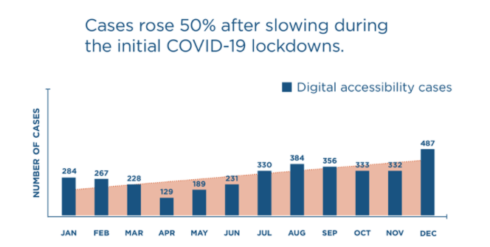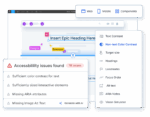
This year, a large number of businesses added new stores, websites, and digital content to serve their customers, but accessibility initiatives did not keep up. In 2020 the number of digital accessibility lawsuits increased by 23%, amounting to almost 10 lawsuits everyday, according to a new report from UsableNet, a digital accessibility company.
In addition to the influx of new digital spaces that could have accessibility issues, plaintiff firms have gotten more efficient at building and filing claims.
Over the course of 2020, there was a slowdown in the number of cases being filed when lockdowns first started happening in March and April. They then started picking back up again over the next months, rising over 50% from March to the end of the year.
RELATED CONTENT: Accessibility in software development
When it comes to who is targeted most in these lawsuits, retailers have it the worst. 77.55% of accessibility lawsuits were associated with retail businesses. Food service had 7.77% of lawsuits, education had 2.45%, and another 3.38% were grouped into an “other” category. All other industries had two percent of lawsuits or less. “In 2020, thousands of retailers have websites and apps. Those websites are complicated. For retailers, web and app content changes happen often. At the same time, web teams have limited resources,” Jason Taylor, chief innovation strategist at UsableNet, wrote in a blog post explaining the report’s results.
There were also a number of repeat lawsuits this year, indicating that even when businesses are reported for accessibility issues, they might still not invest in fixing those issues. Over 20% of the lawsuits this year were for companies that already have been sued in the past two years.
In 2020, 3235 claims were for desktop websites, 296 were for mobile apps, 150 were for video accessibility, 16 were for a combination of web and app, and 3 were for mobile websites. “The type of digital experiences listed in ADA claims are starting to get broader. Video accessibility appeared in digital accessibility lawsuits more often in 2020. It’s easy to argue that missing closed captions or audio descriptions violate the ADA,” Taylor wrote.
In addition, widgets and overlays that are being used to eliminate or reduce accessibility issues don’t always protect companies. According to the report, over 250 claims were filed against companies using such a solution.






